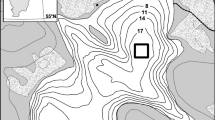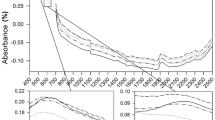Abstract
Visible reflectance spectroscopy (VRS) has been used to reconstruct lake sediment chlorophyll a concentrations. Despite good concordance between inferred and measured chlorophyll a values, questions remain as to whether this spectral technique is tracking past changes in aquatic primary production, or simply recording a diagenetic signal. In this study, we critically evaluate how well VRS chlorophyll a determinations track past trends in aquatic primary production using sediment cores from several lake systems with well-known trophic histories. Our study sites include Arctic, boreal and prairie lakes that encompass a gradient of trophic states. In general, our spectrally inferred chlorophyll a values tracked past trends in lake trophic status consistent with historical measurements of production, or as inferred by independent proxies of primary production. We conclude that VRS chlorophyll a inferences indeed track histories of lake production trends and that this method is widely applicable as a rapid, inexpensive and non-destructive alternative to wet-chemical analyses of sediment chlorophyll a concentrations.










Similar content being viewed by others
References
Birks HH, Birks HJB (2006) Multi-proxy studies in paleolimnology. Veget Hist Archaebot 15:235–251. doi:10.1007/s00334-006-0066-6
Blais JM, Kimpe LE, McMahon D, Keatley B, Mallory ML, Douglas MSV, Smol JP (2005) Arctic seabirds transport marine-derived contaminants. Science 309:445. doi:10.1126/science.1112658
Clarke CC (2007) Comparison between paleolimnological and contemporary data of scaled chrysophytes in Lake 226 (Experimental Lakes Area, Ontario): implications for lake management. BSc (Hons) Thesis. Queen’s University at Kingston, Ontario, Canada, 55 pp
Das B, Vinebrooke RD, Sanchez-Azofeifa A, Rivard B, Wolfe AP (2005) Inferring lake sediment chlorophyll concentrations with reflectance spectroscopy: a novel approach to reconstructing trophic status changes in alpine lakes. Can J Fish Aquat Sci 62:1067–1078. doi:10.1139/f05-016
Douglas MSV, Smol JP (2000) Eutrophication and recovery in the High Arctic: Meretta Lake revisited. Hydrobiologia 431:193–204. doi:10.1023/A:1004000530997
Douglas MSV, Smol JP, Savelle JM, Blais JM (2004) Prehistoric Inuit whalers affected Arctic freshwater ecosystems. Proc Natl Acad Sci USA 101:1613–1617. doi:10.1073/pnas.0307570100
Findlay DL, Kasian SEM (1987) Phytoplankton community responses to nutrient addition in lake 226, Experimental Lakes Area, Northwestern Ontario. Can J Fish Aquat Sci 44:35–46. doi:10.1139/f87-278
Heiman C, Smith K (1991) Clearwater Bay Cottage Pollution Control Program, 1989–1990. Ontario Ministry of the Environment, Kenora, Ontario. Data Report
Hobson KA, Fisk AT, Karnovsky NJ, Holst M, Gagnon JM, Fortier M (2002) A stable isotope (δ13C, δ15N) model for the North water food web: implications for evaluating trophodynamics and the flow of energy and contaminants. Deep Sea Res Part II Top Stud Oceanogr 49:5131–5150. doi:10.1016/S0967-0645(02)00182-0
Keatley BE, Douglas MSV, Blais JM, Mallory ML, Smol JP (2009) Impacts of seabird-derived nutrients on water quality and diatom assemblages from Cape Vera, Devon Island, Canadian High Arctic. Hydrobiologia 621:191–205. doi:10.1007/s10750-008-9670-z
Korsman T, Renberg I, Dåbakk E, Nilssson MB (2001) Near-infrared spectrometry (NIRS) in palaeolimnology. In: Last WN, Smol JP (eds) Tracking environmental changes in lake sediments vol. 2: physical and geochemical methods. Kluwer, Dordrecht, pp 299–317
Last WM, Smol JP (eds) (2001a) Tracking environmental change using lake sediments. Volume 1: basin analysis, coring, and chronological techniques. Kluwer Academic Publishers, Dordrecht, The Netherlands
Last WM, Smol JP (eds) (2001b) Tracking environmental change using lake sediments. Volume 2: physical and geochemical methods. Kluwer Academic Publishers, Dordrecht, The Netherlands
Michels A, Laird KR, Wilson SE, Thompson D, Leavitt PR, Oglesby RJ, Cumming BF (2007) Multidecadal to millennial-scale shifts in drought conditions on the Canadian prairies over the past 6 millennia: implications for future drought assessment. Glob Change Biol 13:1295–1307. doi:10.1111/j.1365-2486.2007.01367.x
Michelutti N, Douglas MSV, Smol JP (2002) Tracking recent recovery from eutrophication in a high arctic lake (Meretta Lake, Cornwallis Island, Nunavut, Canada) using fossil diatom assemblages. J Paleolimnol 28:377–381. doi:10.1023/A:1021654516828
Michelutti N, Wolfe AP, Vinebrooke RD, Rivard B, Briner J (2005) Recent primary production increases in arctic lakes. Geophys Res Lett 32:L19715. doi:10.1029/2005GL023693
Michelutti N, Wolfe AP, Briner JP, Miller GH (2007) Climatically controlled chemical and biological development in Arctic lakes. J Geophys Res 112:G03002. doi:10.1029/2006JG000396
Michelutti N, Blais JM, Liu H, Keatley BE, Douglas MSV, Mallory ML, Smol JP (2008a) A test of the possible influence of seabird activity on the 210Pb flux in high Arctic ponds at Cape Vera, Devon Island, Nunavut: implications for radiochronology. J Paleolimnol 40:783–791. doi:10.1007/s10933-008-9198-2
Michelutti N, Keatley BE, Brimble S, Blais JM, Liu H, Douglas MSV, Mallory ML, Macdonald RW, Smol JP (2008b) Seabird-driven shifts in Arctic pond ecosystems. Proc R Soc Lond B Biol Sci 276:591–596. doi:10.1098/rspb.2008.1103
MOE (1994) Water management: policies, guidelines, provincial water quality objectives of the Ministry of Environment and Energy. Ontario Ministry of Environment and Energy, 67 pp
Pla S, Paterson AM, Smol JP, Clark BJ, Ingram R (2005) Spatial variability in water quality and surface sediment diatom assemblages in a complex lake basin: Lake of the Woods, Ontario, Canada. J Great Lakes Res 31:253–266
Rigler FH (1972) The Char Lake Project. A study of energy flow in a high arctic lake. In: Kajak Z, Hilbricht-Ilkowska A (eds) Productivity problems of freshwaters Proceedings of the IBP-UNESCO Symposium on Productivity Problems of Freshwaters, Kazimierz Dolny, Poland, Warszawa, Kraków, pp 287–300
Schindler DW (1974) Eutrophication and recovery in experimental Lakes: implications for lake management. Science 184:897–899. doi:10.1126/science.184.4139.897
Shearer JA, Fee EJ, DeBruyn ER, DeClercq DR (1987) Phytoplankton productivity changes in a small double-basin lake in response to termination of experimental fertilization. Can J Fish Aquat Sci 44:47–54. doi:10.1139/f87-279
Smol JP, Douglas MSV (2007) From controversy to consensus: making the case for recent climate change in the Arctic using lake sediments. Front Ecol Environ 5:466–474. doi:10.1890/060162
Smol JP, Birks HJB, Last WM (eds) (2001a) Tracking environmental change using lake sediments. Volume 3: terrestrial, algal, and siliceous indicators. Kluwer Academic Publishers, Dordrecht, The Netherlands
Smol JP, Birks HJB, Last WM (eds) (2001b) Tracking environmental change using lake sediments. Volume 4: zoological indicators. Kluwer Academic Publishers, Dordrecht, The Netherlands
Wolfe AP, Vinebrooke RD, Michelutti N, Rivard B, Das B (2006) Experimental calibration of lake-sediment spectral reflectance to chlorophyll a concentrations: methodology and paleolimnological validation. J Paleolimnol 36:91–100. doi:10.1007/s10933-006-0006-6
Acknowledgments
This work was funded by a Natural Sciences and Engineering Research Council (NSERC) grant awarded to JPS. Two anonymous reviewers improved the quality of the manuscript.
Author information
Authors and Affiliations
Corresponding author
Rights and permissions
About this article
Cite this article
Michelutti, N., Blais, J.M., Cumming, B.F. et al. Do spectrally inferred determinations of chlorophyll a reflect trends in lake trophic status?. J Paleolimnol 43, 205–217 (2010). https://doi.org/10.1007/s10933-009-9325-8
Received:
Accepted:
Published:
Issue Date:
DOI: https://doi.org/10.1007/s10933-009-9325-8




